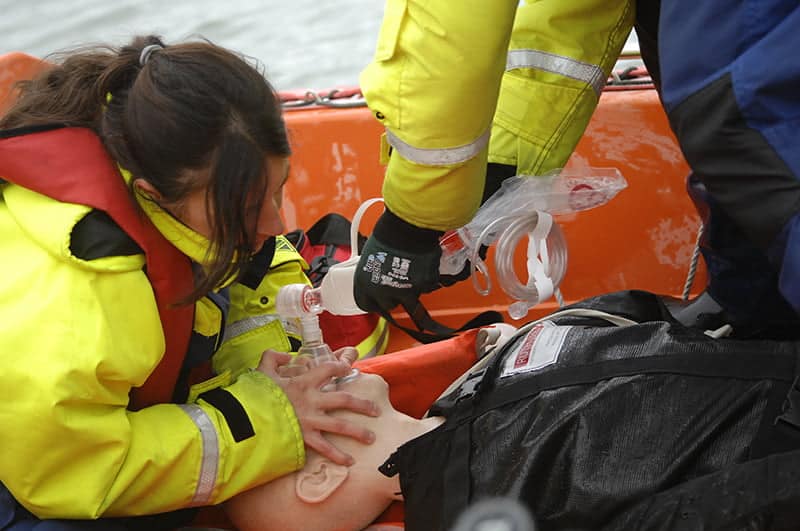Europe’s leading manufacturer of rescue training manikins, Ruth Lee Ltd has teamed up with Lifecast Body Simulation to create the world’s first Advanced Water Rescue manikin.
The Advanced Water Rescue manikin is designed to mimic a drowned person in the water and delivers realistic medical simulation training which prepares rescuers for the real world. No other rescue manikin provides this level of fidelity (Realism), with opportunities to practise rescue skills, coupled with the continuation of care to the Hospital and Intensive Care.
Designed and tested with leading experts
Britain’s elite Military Medical teams (Special Forces) have helped to design and test this revolutionary lifelike manikin as part of intensive training to save lives at sea. The Special Forces Team, which is part of the Royal Navy and which traces its origins back to the Second World War, has been training with the world’s first Advanced Water Rescue manikin, which is so realistic that it even has ‘lungs’.
The RNLI, Bristow Search and Rescue, the UK’s search and rescue helicopter service, several Ambulance Hazardous Area Response Paramedic teams and also the Maritime Skills Academy, have all supported the development of the manikin with rigorous testing and trials.
Highly accurate and lifelike, the £25,000 manikin is a step-change in realism for the rescue training industry. Manikins that have similar advanced medical simulation capabilities frequently cost in excess of £75k, but you certainly couldn’t risk them in open water!
A World First – Drowning Training from rescue to resuscitation
The Advanced Water Rescue manikin floats like an unconscious person but can also be weighted to partially or fully sink to increase the realism of rescue.
When in water, the hydrostatic squeeze (pressure of the water) closes a valve within the lung mechanics. Once rescued from the water, the mechanism releases, creating the movement of the lungs and chest.
Submerging the manikin creates an amount of water in the oropharynx, the middle part of the throat behind the mouth, which can be removed using manual or suction methods.
The drowning mechanism even allows for the manikin to create “foam” to replicate the noises and foaming commonly seen in drowning people. When people drown they can inhale about 30 mls of water into the Lungs, and the manikin is able to replicate this phenomenon, as well as allow for dry lung drownings.
The manikin, which is patent-pending, has taken two years of research and development to perfect.
Paul McDonnell, Managing Director of Ruth Lee, which is based in Corwen, North Wales, said:
“Special Forces teams asked us to create a world-first drowning manikin for them to allow both rescue and critical care training.
“Our innovative product, made in collaboration with Lifecast Body Simulation – Based in Elstree Movie Studios – London, is the first to allow teams to provide true continuity of care.
“It has been specially designed to be rescued from water and allows for lifesaving intervention with the realism of noises and respiratory issues encountered in the real world. It means rescue teams can be trained for the skills they will need in the real world.”
What the experts say
Liz Baugh, who worked for the Royal Navy and is now lead medical consultant at Red Square Medical, which provides medical services for the maritime sector, said:
“I’ve never seen anything like this before.”
“Usually we simulate resuscitation on normal manikins in a classroom environment and simulate man overboard rescues with a manikin in the water, and there’s no link up between the two.
“This manikin enhances our training dramatically not just from the perspective of how it feels to lift a real weight out of the water, but what’s it’s like to resuscitate a realistically feeling body. Because he is so realistic, it adds an additional layer of emotional reaction on top.”
“Bringing this level of realism to my crew is going to enhance their reactions and their responses.”
Adam Khan, a critical care paramedic with Wiltshire Air Ambulance, said:
“Traditionally, training has been quite disjointed. We would have a rescue phase, a resuscitation phase and then the onward care phase.
“There’s no other manikin that offers the same level of fidelity, realism and authenticity as well as being a lifeline in terms of its anatomy and physiology.”
John Schoonraad, creative director of Lifecast Body Simulation, has a background in the movie industry and has worked on films including Saving Private Ryan and Black Hawk Down. He said: “Building a torso to fit within the Ruth Lee body was an exciting project, especially because it can transform lifesaving and technical rescue.
“We are proud to see members of the military and special rescue teams training with this device and we hope it will save many lives.”
Dave Halliwell, Head of Clinical Design at Lifecast Body Simulation said:
“Working in paramedic care for the last 30 years I’ve been lucky to have been involved with projects that are at the Forefront of Clinical Care.
We have utilised the science of drowning, the physiology of the human body, and our joint knowledge of water rescue to design a new type of manikin. We had the support of some of the greatest medics in the world in our testing and we are excited to see how this product will help to transform drowning training around the world.”
In the UK, drowning is one of the leading causes of accidental death in children and every year in the UK and Ireland more than 700 people drown. Hundreds more have near-drowning experiences, sometimes suffering life-changing injuries.
Find out how you could transform your training, call 01490 413 282 or an initial discussion or to arrange a demonstration.
